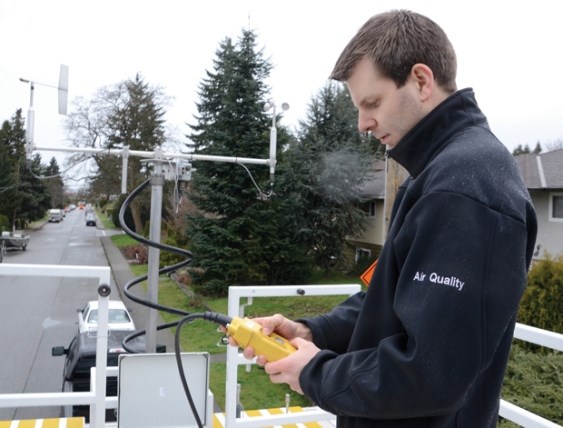Residents in Moodyville can (probably) breathe easy.
A long-awaited study into the port-sidled neighbourhood’s air quality has found pollution levels below Metro Vancouver’s targets in almost every case.
Metro Vancouver parked its pollution-sniffing Mobile Air Monitoring Unit (commonly referred to as MAMU) on East Second Street off and on for nine months between April 2014 and February 2015 to measure carbon monoxide, sulphur dioxide, nitrogen dioxide, ground-level ozone, fine particulate matter, inhalable particulate matter and black carbon.
The study was designed to establish some baseline measures of pollutants coming from the Port of Vancouver’s terminals, train engines, tankers and the Low Level Road before expansions of Neptune Terminals, Richardson International and Cargill Canada came online.
Carbon monoxide peaked at 1,250 parts per billion, well below metro’s objective of 26,500. Sulphur dioxide, which comes from exhaust of oceangoing ships, averaged 1.4 ppb annually. Metro’s objective is to keep that level below 12.
The one exception was for inhalable particulate. For six hours in August 2014, the MAMU detected 52.1 micrograms of particulate per cubic metre, compared to Metro’s objective of 50. At that time, however, the region was under an air quality advisory thanks to forest fires burning outside the Lower Mainland.
“What we saw at Moodyville was the same thing we saw across the region but there was an indication of it being a little bit higher than some of the other stations across the region. We believe that was the impact of local sources. There was construction going on. There are industrial emissions in the area,” said Roger Quan, Metro’s director of air quality and climate change.
Coal was detected amid the fine and coarse particulate samples at varying percentages, but Quan cautioned that the study wasn’t tailored to provide a precise quantitative measure.
City of North Vancouver Mayor Darrell Mussatto said he was happy to see the results. “I think people raised some valid concerns in the past about living that close to an industrial port, with the grain, with the railway, with the potash and coal piles, and they wanted to know it was safe there,” he said. “So we brought the MAMU in for a year and it showed the air quality in that area was very similar to other areas in Metro Vancouver and it was below the levels they needed to be.”
Tony Valente, former chairman of the city’s now-defunct Low Level Road and port area community liaison committee, which originally lobbied for the MAMU, also welcomed the study’s publication.
“On the coal side, there’s probably still some questions but all in all, I think ‘What a great thing.’ You have some independent information that is a pretty good outcome. It complies with Metro Vancouver for the most part. ... I don’t know why it was so difficult to get the information in the first place. ... I hope it brings a lot of calm to folks.”
While many port expansion projects are complete, Valente said Metro Vancouver should watch air quality from its permanent monitoring stations in Mahon Park, Horseshoe Bay and Maplewood.
Still one massive terminal project has yet to be approved. G3 has applied to build a rail loop and 48 silos capable of holding 180,000 tonnes of grain at the foot of Brooksbank Avenue, something the city has been keeping a close eye on, Mussatto said.
“We want to make sure that any changes at the port can work alongside residents who are already living there. We sent those concerns off to (the Vancouver Fraser Port Authority) and G3. I understand they’re in the process of responding to them and I’m hoping when it comes back, they’ll going to be able to address all those concerns.”
The elevator and silo technology proposed for G3 is much more advanced than the existing terminals on the waterfront, Mussatto noted. City staff toured a similar facility in Washington State and were “quite impressed” with what they saw, he said.
“I’m hoping, on balance, it’s a benefit to the area,” he said.
The port authority’s decision on G3’s application is due in late spring or early summer.



